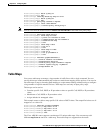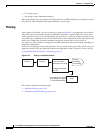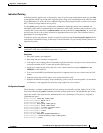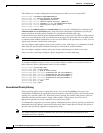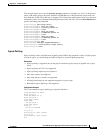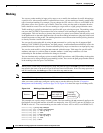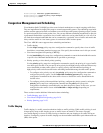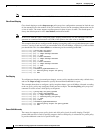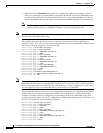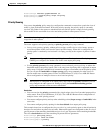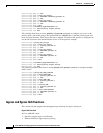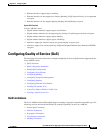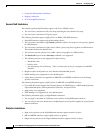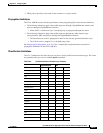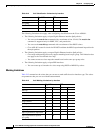
24-21
Cisco ASR 901 Series Aggregation Services Router Software Configuration Guide
OL-23826-09
Chapter 24 Configuring QoS
Understanding QoS
The first policy level, the parent level, is used for port shaping, and you can specific only one class of
type class-default within the policy. This is an example of a parent-level policy map:
Router(config)# policy-map parent
Router(config-pmap)# class class-default
Router(config-pmap-c)# shape average 50000000
Router(config-pmap-c)# exit
The second policy level, the child level, is used to control a specific traffic stream or class, as in this
example:
Router(config)# policy-map child
Router(config-pmap)# class class1
Router(config-pmap-c)# priority
Router(config-pmap-c)# exit
Note The total of the minimum bandwidth guarantees (CIR) for each queue of the child policy cannot exceed
the total port-shape rate.
This is an example of a parent-child configuration:
Router(config)# policy-map parent
Router(config-pmap)# class class-default
Router(config-pmap-c)# shape average 50000000
Router(config-pmap-c)# service-policy child
Router(config-pmap-c)# exit
Router(config-pmap)# exit
Router(config)# interface gigabitethernet0/1
Router(config-if)# service-policy output parent
Router(config-if)# exit
Class-Based Weighted Fair Queuing
You can configure class-based weighted fair queuing (CBWFQ) to set the relative precedence of a queue
by allocating a portion of the total bandwidth that is available for the port. Use the bandwidth
policy-map class configuration command to set the output bandwidth for a class of traffic as a percentage
of total bandwidth, or a percentage of remaining bandwidth.
Note When you configure bandwidth in a policy map, you must configure all rates in the same format. The
total of the minimum bandwidth guarantees (CIR) for each queue of the policy cannot exceed the total
speed of the parent.
• When you use the bandwidth policy-map class configuration command to configure a class of
traffic as a percentage of total bandwidth, it represents the minimum bandwidth guarantee (CIR) for
that traffic class. This means that the traffic class gets at least the bandwidth indicated by the
command, but is not limited to that bandwidth. Any excess bandwidth on the port is allocated to each
class in the same ratio in which the CIR rates are configured.
Note You cannot configure bandwidth as a percentage of total bandwidth when strict priority (priority
without police) is configured for another class in the output policy.



